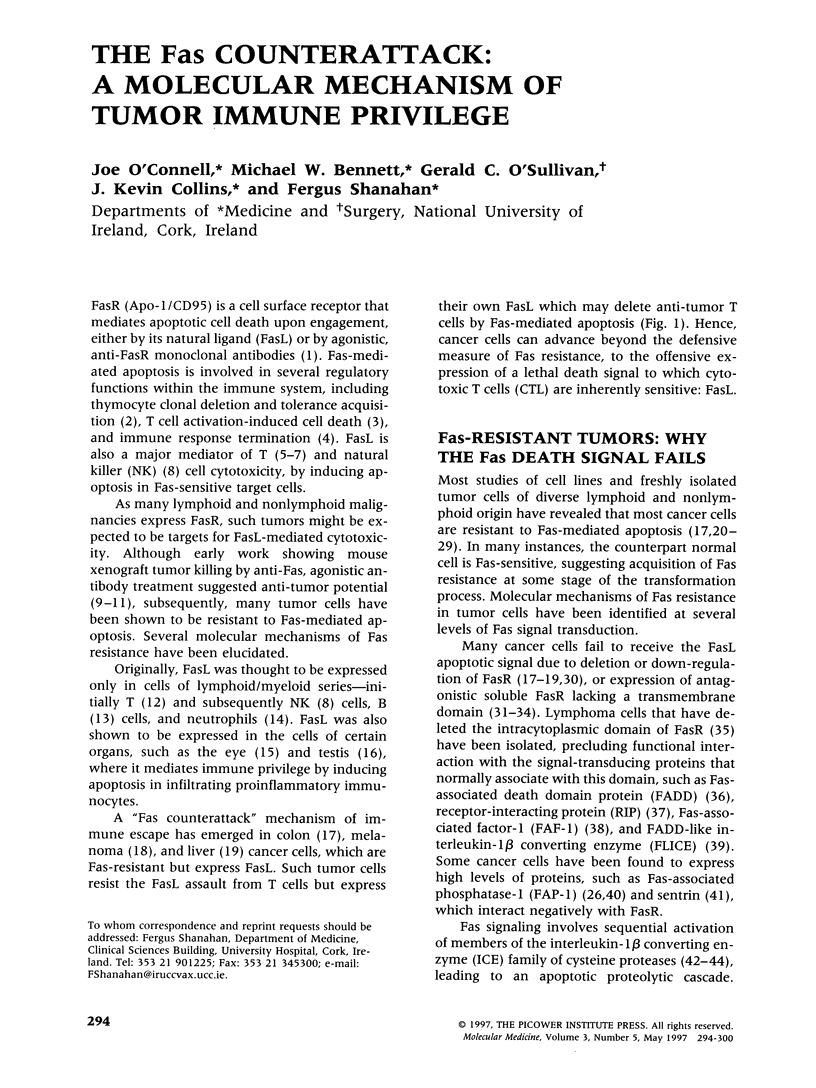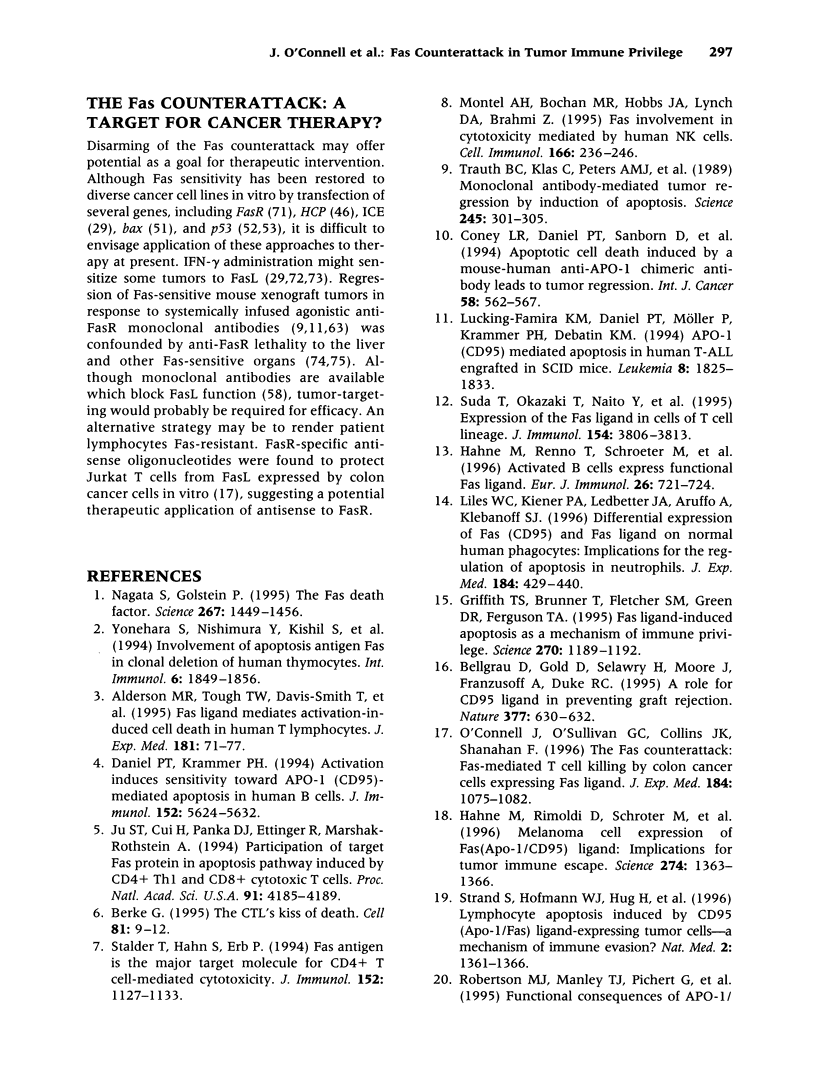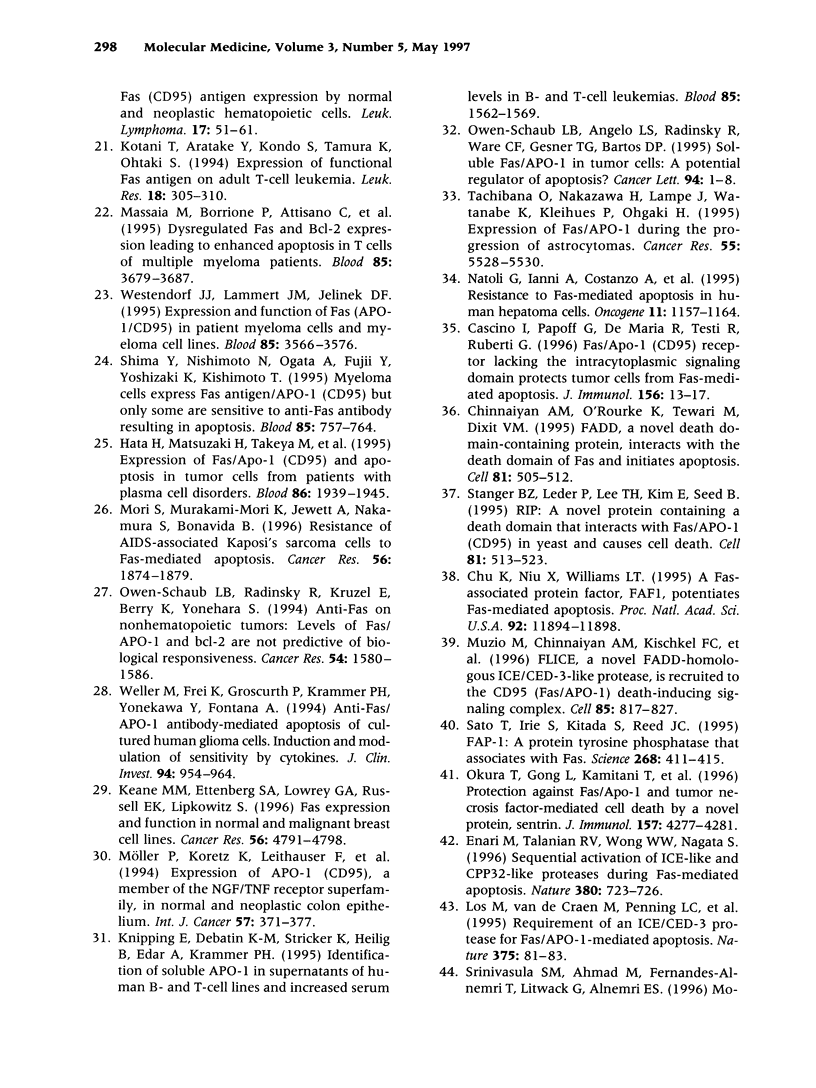Full text
PDF






Selected References
These references are in PubMed. This may not be the complete list of references from this article.
- Abreu-Martin M. T., Vidrich A., Lynch D. H., Targan S. R. Divergent induction of apoptosis and IL-8 secretion in HT-29 cells in response to TNF-alpha and ligation of Fas antigen. J Immunol. 1995 Nov 1;155(9):4147–4154. [PubMed] [Google Scholar]
- Alderson M. R., Tough T. W., Davis-Smith T., Braddy S., Falk B., Schooley K. A., Goodwin R. G., Smith C. A., Ramsdell F., Lynch D. H. Fas ligand mediates activation-induced cell death in human T lymphocytes. J Exp Med. 1995 Jan 1;181(1):71–77. doi: 10.1084/jem.181.1.71. [DOI] [PMC free article] [PubMed] [Google Scholar]
- Bargou R. C., Daniel P. T., Mapara M. Y., Bommert K., Wagener C., Kallinich B., Royer H. D., Dörken B. Expression of the bcl-2 gene family in normal and malignant breast tissue: low bax-alpha expression in tumor cells correlates with resistance towards apoptosis. Int J Cancer. 1995 Mar 16;60(6):854–859. doi: 10.1002/ijc.2910600622. [DOI] [PubMed] [Google Scholar]
- Bargou R. C., Wagener C., Bommert K., Mapara M. Y., Daniel P. T., Arnold W., Dietel M., Guski H., Feller A., Royer H. D. Overexpression of the death-promoting gene bax-alpha which is downregulated in breast cancer restores sensitivity to different apoptotic stimuli and reduces tumor growth in SCID mice. J Clin Invest. 1996 Jun 1;97(11):2651–2659. doi: 10.1172/JCI118715. [DOI] [PMC free article] [PubMed] [Google Scholar]
- Bellgrau D., Gold D., Selawry H., Moore J., Franzusoff A., Duke R. C. A role for CD95 ligand in preventing graft rejection. Nature. 1995 Oct 19;377(6550):630–632. doi: 10.1038/377630a0. [DOI] [PubMed] [Google Scholar]
- Berke G. The CTL's kiss of death. Cell. 1995 Apr 7;81(1):9–12. doi: 10.1016/0092-8674(95)90365-8. [DOI] [PubMed] [Google Scholar]
- Browning J. L., Miatkowski K., Sizing I., Griffiths D., Zafari M., Benjamin C. D., Meier W., Mackay F. Signaling through the lymphotoxin beta receptor induces the death of some adenocarcinoma tumor lines. J Exp Med. 1996 Mar 1;183(3):867–878. doi: 10.1084/jem.183.3.867. [DOI] [PMC free article] [PubMed] [Google Scholar]
- Cascino I., Papoff G., De Maria R., Testi R., Ruberti G. Fas/Apo-1 (CD95) receptor lacking the intracytoplasmic signaling domain protects tumor cells from Fas-mediated apoptosis. J Immunol. 1996 Jan 1;156(1):13–17. [PubMed] [Google Scholar]
- Chinnaiyan A. M., O'Rourke K., Tewari M., Dixit V. M. FADD, a novel death domain-containing protein, interacts with the death domain of Fas and initiates apoptosis. Cell. 1995 May 19;81(4):505–512. doi: 10.1016/0092-8674(95)90071-3. [DOI] [PubMed] [Google Scholar]
- Chu K., Niu X., Williams L. T. A Fas-associated protein factor, FAF1, potentiates Fas-mediated apoptosis. Proc Natl Acad Sci U S A. 1995 Dec 5;92(25):11894–11898. doi: 10.1073/pnas.92.25.11894. [DOI] [PMC free article] [PubMed] [Google Scholar]
- Coney L. R., Daniel P. T., Sanborn D., Dhein J., Debatin K. M., Krammer P. H., Zurawski V. R., Jr Apoptotic cell death induced by a mouse-human anti-APO-1 chimeric antibody leads to tumor regression. Int J Cancer. 1994 Aug 15;58(4):562–567. doi: 10.1002/ijc.2910580419. [DOI] [PubMed] [Google Scholar]
- Daniel P. T., Krammer P. H. Activation induces sensitivity toward APO-1 (CD95)-mediated apoptosis in human B cells. J Immunol. 1994 Jun 15;152(12):5624–5632. [PubMed] [Google Scholar]
- Enari M., Talanian R. V., Wong W. W., Nagata S. Sequential activation of ICE-like and CPP32-like proteases during Fas-mediated apoptosis. Nature. 1996 Apr 25;380(6576):723–726. doi: 10.1038/380723a0. [DOI] [PubMed] [Google Scholar]
- Friesen C., Herr I., Krammer P. H., Debatin K. M. Involvement of the CD95 (APO-1/FAS) receptor/ligand system in drug-induced apoptosis in leukemia cells. Nat Med. 1996 May;2(5):574–577. doi: 10.1038/nm0596-574. [DOI] [PubMed] [Google Scholar]
- Griffith T. S., Brunner T., Fletcher S. M., Green D. R., Ferguson T. A. Fas ligand-induced apoptosis as a mechanism of immune privilege. Science. 1995 Nov 17;270(5239):1189–1192. doi: 10.1126/science.270.5239.1189. [DOI] [PubMed] [Google Scholar]
- Hahne M., Renno T., Schroeter M., Irmler M., French L., Bornard T., MacDonald H. R., Tschopp J. Activated B cells express functional Fas ligand. Eur J Immunol. 1996 Mar;26(3):721–724. doi: 10.1002/eji.1830260332. [DOI] [PubMed] [Google Scholar]
- Hahne M., Rimoldi D., Schröter M., Romero P., Schreier M., French L. E., Schneider P., Bornand T., Fontana A., Lienard D. Melanoma cell expression of Fas(Apo-1/CD95) ligand: implications for tumor immune escape. Science. 1996 Nov 22;274(5291):1363–1366. doi: 10.1126/science.274.5291.1363. [DOI] [PubMed] [Google Scholar]
- Hata H., Matsuzaki H., Takeya M., Yoshida M., Sonoki T., Nagasaki A., Kuribayashi N., Kawano F., Takatsuki K. Expression of Fas/Apo-1 (CD95) and apoptosis in tumor cells from patients with plasma cell disorders. Blood. 1995 Sep 1;86(5):1939–1945. [PubMed] [Google Scholar]
- Irmler M., Hertig S., MacDonald H. R., Sadoul R., Becherer J. D., Proudfoot A., Solari R., Tschopp J. Granzyme A is an interleukin 1 beta-converting enzyme. J Exp Med. 1995 May 1;181(5):1917–1922. doi: 10.1084/jem.181.5.1917. [DOI] [PMC free article] [PubMed] [Google Scholar]
- Itoh N., Tsujimoto Y., Nagata S. Effect of bcl-2 on Fas antigen-mediated cell death. J Immunol. 1993 Jul 15;151(2):621–627. [PubMed] [Google Scholar]
- Ju S. T., Cui H., Panka D. J., Ettinger R., Marshak-Rothstein A. Participation of target Fas protein in apoptosis pathway induced by CD4+ Th1 and CD8+ cytotoxic T cells. Proc Natl Acad Sci U S A. 1994 May 10;91(10):4185–4189. doi: 10.1073/pnas.91.10.4185. [DOI] [PMC free article] [PubMed] [Google Scholar]
- Jättelä M., Benedict M., Tewari M., Shayman J. A., Dixit V. M. Bcl-x and Bcl-2 inhibit TNF and Fas-induced apoptosis and activation of phospholipase A2 in breast carcinoma cells. Oncogene. 1995 Jun 15;10(12):2297–2305. [PubMed] [Google Scholar]
- Keane M. M., Ettenberg S. A., Lowrey G. A., Russell E. K., Lipkowitz S. Fas expression and function in normal and malignant breast cell lines. Cancer Res. 1996 Oct 15;56(20):4791–4798. [PubMed] [Google Scholar]
- Knipping E., Debatin K. M., Stricker K., Heilig B., Eder A., Krammer P. H. Identification of soluble APO-1 in supernatants of human B- and T-cell lines and increased serum levels in B- and T-cell leukemias. Blood. 1995 Mar 15;85(6):1562–1569. [PubMed] [Google Scholar]
- Kondo S., Barna B. P., Morimura T., Takeuchi J., Yuan J., Akbasak A., Barnett G. H. Interleukin-1 beta-converting enzyme mediates cisplatin-induced apoptosis in malignant glioma cells. Cancer Res. 1995 Dec 15;55(24):6166–6171. [PubMed] [Google Scholar]
- Korbutt G. S., Elliott J. F., Rajotte R. V. Cotransplantation of allogeneic islets with allogeneic testicular cell aggregates allows long-term graft survival without systemic immunosuppression. Diabetes. 1997 Feb;46(2):317–322. doi: 10.2337/diab.46.2.317. [DOI] [PubMed] [Google Scholar]
- Kotani T., Aratake Y., Kondo S., Tamura K., Ohtaki S. Expression of functional Fas antigen on adult T-cell leukemia. Leuk Res. 1994 Apr;18(4):305–310. doi: 10.1016/0145-2126(94)90034-5. [DOI] [PubMed] [Google Scholar]
- Lau H. T., Yu M., Fontana A., Stoeckert C. J., Jr Prevention of islet allograft rejection with engineered myoblasts expressing FasL in mice. Science. 1996 Jul 5;273(5271):109–112. doi: 10.1126/science.273.5271.109. [DOI] [PubMed] [Google Scholar]
- Liles W. C., Kiener P. A., Ledbetter J. A., Aruffo A., Klebanoff S. J. Differential expression of Fas (CD95) and Fas ligand on normal human phagocytes: implications for the regulation of apoptosis in neutrophils. J Exp Med. 1996 Aug 1;184(2):429–440. doi: 10.1084/jem.184.2.429. [DOI] [PMC free article] [PubMed] [Google Scholar]
- Los M., Van de Craen M., Penning L. C., Schenk H., Westendorp M., Baeuerle P. A., Dröge W., Krammer P. H., Fiers W., Schulze-Osthoff K. Requirement of an ICE/CED-3 protease for Fas/APO-1-mediated apoptosis. Nature. 1995 May 4;375(6526):81–83. doi: 10.1038/375081a0. [DOI] [PubMed] [Google Scholar]
- Lücking-Famira K. M., Daniel P. T., Möller P., Krammer P. H., Debatin K. M. APO-1 (CD95) mediated apoptosis in human T-ALL engrafted in SCID mice. Leukemia. 1994 Nov;8(11):1825–1833. [PubMed] [Google Scholar]
- Massaia M., Borrione P., Attisano C., Barral P., Beggiato E., Montacchini L., Bianchi A., Boccadoro M., Pileri A. Dysregulated Fas and Bcl-2 expression leading to enhanced apoptosis in T cells of multiple myeloma patients. Blood. 1995 Jun 15;85(12):3679–3687. [PubMed] [Google Scholar]
- McGahon A. J., Nishioka W. K., Martin S. J., Mahboubi A., Cotter T. G., Green D. R. Regulation of the Fas apoptotic cell death pathway by Abl. J Biol Chem. 1995 Sep 22;270(38):22625–22631. doi: 10.1074/jbc.270.38.22625. [DOI] [PubMed] [Google Scholar]
- Montel A. H., Bochan M. R., Hobbs J. A., Lynch D. H., Brahmi Z. Fas involvement in cytotoxicity mediated by human NK cells. Cell Immunol. 1995 Dec;166(2):236–246. doi: 10.1006/cimm.1995.9974. [DOI] [PubMed] [Google Scholar]
- Mori S., Murakami-Mori K., Jewett A., Nakamura S., Bonavida B. Resistance of AIDS-associated Kaposi's sarcoma cells to Fas-mediated apoptosis. Cancer Res. 1996 Apr 15;56(8):1874–1879. [PubMed] [Google Scholar]
- Muzio M., Chinnaiyan A. M., Kischkel F. C., O'Rourke K., Shevchenko A., Ni J., Scaffidi C., Bretz J. D., Zhang M., Gentz R. FLICE, a novel FADD-homologous ICE/CED-3-like protease, is recruited to the CD95 (Fas/APO-1) death--inducing signaling complex. Cell. 1996 Jun 14;85(6):817–827. doi: 10.1016/s0092-8674(00)81266-0. [DOI] [PubMed] [Google Scholar]
- Möller P., Koretz K., Leithäuser F., Brüderlein S., Henne C., Quentmeier A., Krammer P. H. Expression of APO-1 (CD95), a member of the NGF/TNF receptor superfamily, in normal and neoplastic colon epithelium. Int J Cancer. 1994 May 1;57(3):371–377. doi: 10.1002/ijc.2910570314. [DOI] [PubMed] [Google Scholar]
- Müller M., Strand S., Hug H., Heinemann E. M., Walczak H., Hofmann W. J., Stremmel W., Krammer P. H., Galle P. R. Drug-induced apoptosis in hepatoma cells is mediated by the CD95 (APO-1/Fas) receptor/ligand system and involves activation of wild-type p53. J Clin Invest. 1997 Feb 1;99(3):403–413. doi: 10.1172/JCI119174. [DOI] [PMC free article] [PubMed] [Google Scholar]
- Nagata S., Golstein P. The Fas death factor. Science. 1995 Mar 10;267(5203):1449–1456. doi: 10.1126/science.7533326. [DOI] [PubMed] [Google Scholar]
- Natoli G., Ianni A., Costanzo A., De Petrillo G., Ilari I., Chirillo P., Balsano C., Levrero M. Resistance to Fas-mediated apoptosis in human hepatoma cells. Oncogene. 1995 Sep 21;11(6):1157–1164. [PubMed] [Google Scholar]
- O'Connell J., O'Sullivan G. C., Collins J. K., Shanahan F. The Fas counterattack: Fas-mediated T cell killing by colon cancer cells expressing Fas ligand. J Exp Med. 1996 Sep 1;184(3):1075–1082. doi: 10.1084/jem.184.3.1075. [DOI] [PMC free article] [PubMed] [Google Scholar]
- Ogasawara J., Watanabe-Fukunaga R., Adachi M., Matsuzawa A., Kasugai T., Kitamura Y., Itoh N., Suda T., Nagata S. Lethal effect of the anti-Fas antibody in mice. Nature. 1993 Aug 26;364(6440):806–809. doi: 10.1038/364806a0. [DOI] [PubMed] [Google Scholar]
- Okura T., Gong L., Kamitani T., Wada T., Okura I., Wei C. F., Chang H. M., Yeh E. T. Protection against Fas/APO-1- and tumor necrosis factor-mediated cell death by a novel protein, sentrin. J Immunol. 1996 Nov 15;157(10):4277–4281. [PubMed] [Google Scholar]
- Owen-Schaub L. B., Angelo L. S., Radinsky R., Ware C. F., Gesner T. G., Bartos D. P. Soluble Fas/APO-1 in tumor cells: a potential regulator of apoptosis? Cancer Lett. 1995 Jul 20;94(1):1–8. doi: 10.1016/0304-3835(95)03834-j. [DOI] [PubMed] [Google Scholar]
- Owen-Schaub L. B., Radinsky R., Kruzel E., Berry K., Yonehara S. Anti-Fas on nonhematopoietic tumors: levels of Fas/APO-1 and bcl-2 are not predictive of biological responsiveness. Cancer Res. 1994 Mar 15;54(6):1580–1586. [PubMed] [Google Scholar]
- Owen-Schaub L. B., Zhang W., Cusack J. C., Angelo L. S., Santee S. M., Fujiwara T., Roth J. A., Deisseroth A. B., Zhang W. W., Kruzel E. Wild-type human p53 and a temperature-sensitive mutant induce Fas/APO-1 expression. Mol Cell Biol. 1995 Jun;15(6):3032–3040. doi: 10.1128/mcb.15.6.3032. [DOI] [PMC free article] [PubMed] [Google Scholar]
- Peng S. L., Robert M. E., Hayday A. C., Craft J. A tumor-suppressor function for Fas (CD95) revealed in T cell-deficient mice. J Exp Med. 1996 Sep 1;184(3):1149–1154. doi: 10.1084/jem.184.3.1149. [DOI] [PMC free article] [PubMed] [Google Scholar]
- Quan L. T., Caputo A., Bleackley R. C., Pickup D. J., Salvesen G. S. Granzyme B is inhibited by the cowpox virus serpin cytokine response modifier A. J Biol Chem. 1995 May 5;270(18):10377–10379. doi: 10.1074/jbc.270.18.10377. [DOI] [PubMed] [Google Scholar]
- Rayner A. A., Grimm E. A., Lotze M. T., Chu E. W., Rosenberg S. A. Lymphokine-activated killer (LAK) cells. Analysis of factors relevant to the immunotherapy of human cancer. Cancer. 1985 Mar 15;55(6):1327–1333. doi: 10.1002/1097-0142(19850315)55:6<1327::aid-cncr2820550628>3.0.co;2-o. [DOI] [PubMed] [Google Scholar]
- Rodriguez I., Matsuura K., Ody C., Nagata S., Vassalli P. Systemic injection of a tripeptide inhibits the intracellular activation of CPP32-like proteases in vivo and fully protects mice against Fas-mediated fulminant liver destruction and death. J Exp Med. 1996 Nov 1;184(5):2067–2072. doi: 10.1084/jem.184.5.2067. [DOI] [PMC free article] [PubMed] [Google Scholar]
- Sato T., Irie S., Kitada S., Reed J. C. FAP-1: a protein tyrosine phosphatase that associates with Fas. Science. 1995 Apr 21;268(5209):411–415. doi: 10.1126/science.7536343. [DOI] [PubMed] [Google Scholar]
- Schott A. F., Apel I. J., Nuñez G., Clarke M. F. Bcl-XL protects cancer cells from p53-mediated apoptosis. Oncogene. 1995 Oct 5;11(7):1389–1394. [PubMed] [Google Scholar]
- Schröter M., Lowin B., Borner C., Tschopp J. Regulation of Fas(Apo-1/CD95)- and perforin-mediated lytic pathways of primary cytotoxic T lymphocytes by the protooncogene bcl-2. Eur J Immunol. 1995 Dec;25(12):3509–3513. doi: 10.1002/eji.1830251245. [DOI] [PubMed] [Google Scholar]
- Shima Y., Nishimoto N., Ogata A., Fujii Y., Yoshizaki K., Kishimoto T. Myeloma cells express Fas antigen/APO-1 (CD95) but only some are sensitive to anti-Fas antibody resulting in apoptosis. Blood. 1995 Feb 1;85(3):757–764. [PubMed] [Google Scholar]
- Stalder T., Hahn S., Erb P. Fas antigen is the major target molecule for CD4+ T cell-mediated cytotoxicity. J Immunol. 1994 Feb 1;152(3):1127–1133. [PubMed] [Google Scholar]
- Stanger B. Z., Leder P., Lee T. H., Kim E., Seed B. RIP: a novel protein containing a death domain that interacts with Fas/APO-1 (CD95) in yeast and causes cell death. Cell. 1995 May 19;81(4):513–523. doi: 10.1016/0092-8674(95)90072-1. [DOI] [PubMed] [Google Scholar]
- Strand S., Hofmann W. J., Hug H., Müller M., Otto G., Strand D., Mariani S. M., Stremmel W., Krammer P. H., Galle P. R. Lymphocyte apoptosis induced by CD95 (APO-1/Fas) ligand-expressing tumor cells--a mechanism of immune evasion? Nat Med. 1996 Dec;2(12):1361–1366. doi: 10.1038/nm1296-1361. [DOI] [PubMed] [Google Scholar]
- Stuart P. M., Griffith T. S., Usui N., Pepose J., Yu X., Ferguson T. A. CD95 ligand (FasL)-induced apoptosis is necessary for corneal allograft survival. J Clin Invest. 1997 Feb 1;99(3):396–402. doi: 10.1172/JCI119173. [DOI] [PMC free article] [PubMed] [Google Scholar]
- Su X., Zhou T., Wang Z., Yang P., Jope R. S., Mountz J. D. Defective expression of hematopoietic cell protein tyrosine phosphatase (HCP) in lymphoid cells blocks Fas-mediated apoptosis. Immunity. 1995 Apr;2(4):353–362. doi: 10.1016/1074-7613(95)90143-4. [DOI] [PubMed] [Google Scholar]
- Suda T., Okazaki T., Naito Y., Yokota T., Arai N., Ozaki S., Nakao K., Nagata S. Expression of the Fas ligand in cells of T cell lineage. J Immunol. 1995 Apr 15;154(8):3806–3813. [PubMed] [Google Scholar]
- Tachibana O., Nakazawa H., Lampe J., Watanabe K., Kleihues P., Ohgaki H. Expression of Fas/APO-1 during the progression of astrocytomas. Cancer Res. 1995 Dec 1;55(23):5528–5530. [PubMed] [Google Scholar]
- Tamura T., Aoyama N., Saya H., Haga H., Futami S., Miyamoto M., Koh T., Ariyasu T., Tachi M., Kasuga M. Induction of Fas-mediated apoptosis in p53-transfected human colon carcinoma cells. Oncogene. 1995 Nov 16;11(10):1939–1946. [PubMed] [Google Scholar]
- Tamura T., Ueda S., Yoshida M., Matsuzaki M., Mohri H., Okubo T. Interferon-gamma induces Ice gene expression and enhances cellular susceptibility to apoptosis in the U937 leukemia cell line. Biochem Biophys Res Commun. 1996 Dec 4;229(1):21–26. doi: 10.1006/bbrc.1996.1752. [DOI] [PubMed] [Google Scholar]
- Tanaka M., Suda T., Haze K., Nakamura N., Sato K., Kimura F., Motoyoshi K., Mizuki M., Tagawa S., Ohga S. Fas ligand in human serum. Nat Med. 1996 Mar;2(3):317–322. doi: 10.1038/nm0396-317. [DOI] [PubMed] [Google Scholar]
- Trauth B. C., Klas C., Peters A. M., Matzku S., Möller P., Falk W., Debatin K. M., Krammer P. H. Monoclonal antibody-mediated tumor regression by induction of apoptosis. Science. 1989 Jul 21;245(4915):301–305. doi: 10.1126/science.2787530. [DOI] [PubMed] [Google Scholar]
- Weller M., Frei K., Groscurth P., Krammer P. H., Yonekawa Y., Fontana A. Anti-Fas/APO-1 antibody-mediated apoptosis of cultured human glioma cells. Induction and modulation of sensitivity by cytokines. J Clin Invest. 1994 Sep;94(3):954–964. doi: 10.1172/JCI117462. [DOI] [PMC free article] [PubMed] [Google Scholar]
- Weller M., Malipiero U., Aguzzi A., Reed J. C., Fontana A. Protooncogene bcl-2 gene transfer abrogates Fas/APO-1 antibody-mediated apoptosis of human malignant glioma cells and confers resistance to chemotherapeutic drugs and therapeutic irradiation. J Clin Invest. 1995 Jun;95(6):2633–2643. doi: 10.1172/JCI117965. [DOI] [PMC free article] [PubMed] [Google Scholar]
- Weller M., Malipiero U., Rensing-Ehl A., Barr P. J., Fontana A. Fas/APO-1 gene transfer for human malignant glioma. Cancer Res. 1995 Jul 1;55(13):2936–2944. [PubMed] [Google Scholar]
- Westendorf J. J., Lammert J. M., Jelinek D. F. Expression and function of Fas (APO-1/CD95) in patient myeloma cells and myeloma cell lines. Blood. 1995 Jun 15;85(12):3566–3576. [PubMed] [Google Scholar]
- Yonehara S., Nishimura Y., Kishil S., Yonehara M., Takazawa K., Tamatani T., Ishii A. Involvement of apoptosis antigen Fas in clonal deletion of human thymocytes. Int Immunol. 1994 Dec;6(12):1849–1856. doi: 10.1093/intimm/6.12.1849. [DOI] [PubMed] [Google Scholar]
- Zörnig M., Grzeschiczek A., Kowalski M. B., Hartmann K. U., Möröy T. Loss of Fas/Apo-1 receptor accelerates lymphomagenesis in E mu L-MYC transgenic mice but not in animals infected with MoMuLV. Oncogene. 1995 Jun 15;10(12):2397–2401. [PubMed] [Google Scholar]
- van den Broek M. E., Kägi D., Ossendorp F., Toes R., Vamvakas S., Lutz W. K., Melief C. J., Zinkernagel R. M., Hengartner H. Decreased tumor surveillance in perforin-deficient mice. J Exp Med. 1996 Nov 1;184(5):1781–1790. doi: 10.1084/jem.184.5.1781. [DOI] [PMC free article] [PubMed] [Google Scholar]


